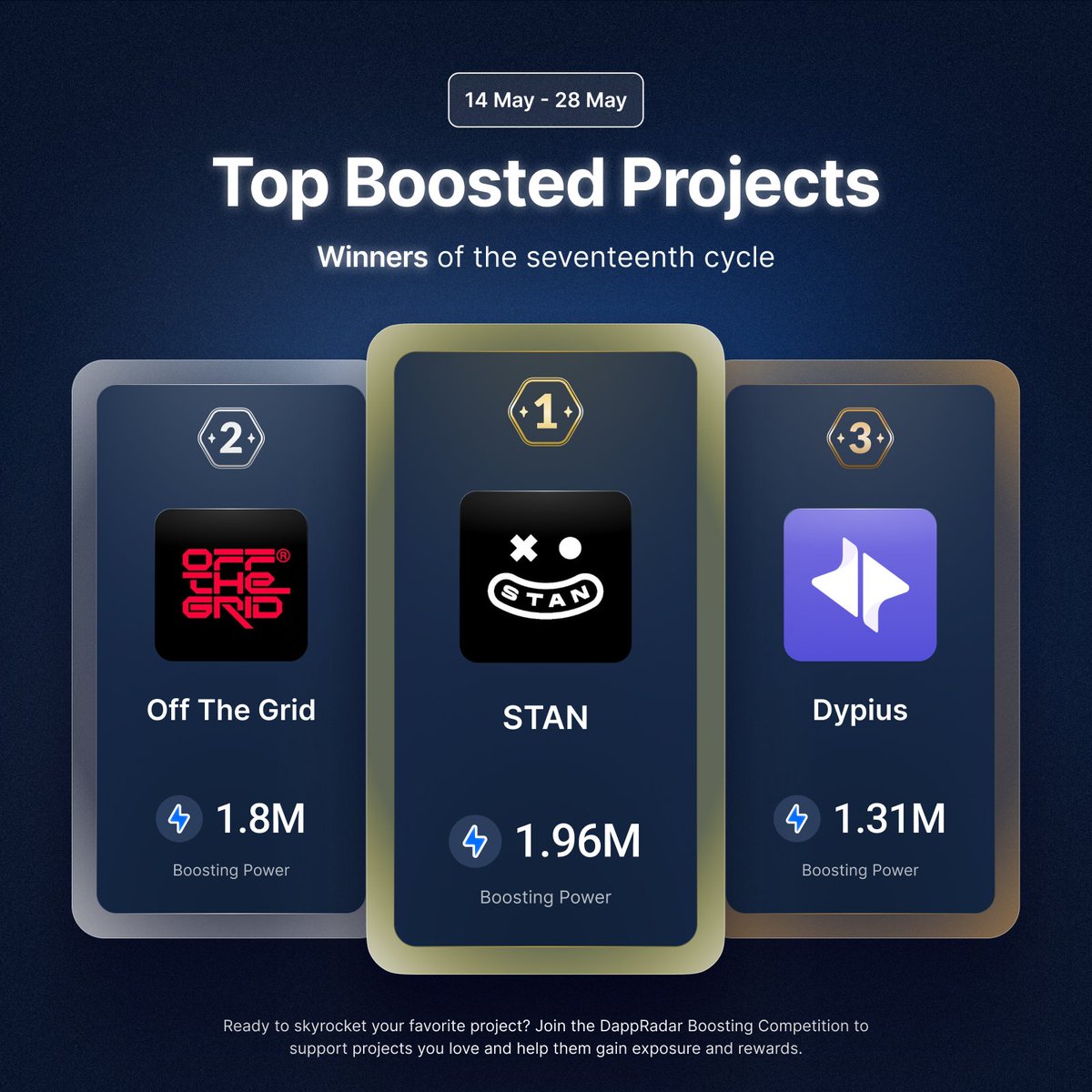
RADAR
DappRadar koers
$0,0032710
+$0,000021000
(+0,64%)
Prijsverandering voor de afgelopen 24 uur

Wat vind je vandaag van RADAR?
Deel je mening hier door een duim omhoog te geven als je je bullish voelt over een munt of een duim omlaag als je je bearish voelt.
Stem om resultaten te bekijken
Disclaimer
De sociale inhoud op deze pagina ("Inhoud"), inclusief maar niet beperkt tot tweets en statistieken die door LunarCrush worden verstrekt, is afkomstig van derden en wordt alleen voor informatieve doeleinden geleverd "zoals deze is". OKX geeft geen garantie voor de kwaliteit of nauwkeurigheid van de Inhoud en de Inhoud vertegenwoordigt niet de standpunten van OKX. Het is niet bedoeld om (i) beleggingsadvies of een beleggingsaanbeveling te geven; (ii) een aanbod of verzoek om digitale bezitting te kopen, verkopen of te bezitten; of (iii) financieel, boekhoudkundig, juridisch of fiscaal advies. Digitale bezittingen, waaronder stablecoins en NFT's, brengt een hoog risico met zich mee en kan sterk fluctueren. De prijs en prestaties van de digitale bezittingen zijn niet gegarandeerd en kunnen zonder voorafgaande kennisgeving worden gewijzigd.
OKX geeft geen beleggings- of vermogensadvies. Je moet zorgvuldig overwegen of het verhandelen of bezitten van digitale bezittingen voor jou geschikt is in het licht van je financiële toestand. Raadpleeg je juridische, fiscale of beleggingsadviseur als je vragen hebt over je specifieke situatie. Raadpleeg voor meer informatie onze Gebruiksvoorwaarden en Risicowaarschuwing. Door gebruik te maken van de website van derden ('TPW'), ga je ermee akkoord dat elk gebruik van de TPW onderworpen is aan en beheerst wordt door de voorwaarden van de TPW. Tenzij uitdrukkelijk schriftelijk vermeld, zijn OKX en haar partners ("OKX") op geen enkele manier verbonden met de eigenaar van de exploitant van de TPW. Je gaat ermee akkoord dat OKX niet verantwoordelijk of aansprakelijk is voor verlies, schade en andere gevolgen die voortvloeien uit jouw gebruik van de TPW. Houd er rekening mee dat het gebruik van een TPW kan leiden tot verlies of vermindering van je bezittingen. Het product is mogelijk niet in alle rechtsgebieden beschikbaar.
OKX geeft geen beleggings- of vermogensadvies. Je moet zorgvuldig overwegen of het verhandelen of bezitten van digitale bezittingen voor jou geschikt is in het licht van je financiële toestand. Raadpleeg je juridische, fiscale of beleggingsadviseur als je vragen hebt over je specifieke situatie. Raadpleeg voor meer informatie onze Gebruiksvoorwaarden en Risicowaarschuwing. Door gebruik te maken van de website van derden ('TPW'), ga je ermee akkoord dat elk gebruik van de TPW onderworpen is aan en beheerst wordt door de voorwaarden van de TPW. Tenzij uitdrukkelijk schriftelijk vermeld, zijn OKX en haar partners ("OKX") op geen enkele manier verbonden met de eigenaar van de exploitant van de TPW. Je gaat ermee akkoord dat OKX niet verantwoordelijk of aansprakelijk is voor verlies, schade en andere gevolgen die voortvloeien uit jouw gebruik van de TPW. Houd er rekening mee dat het gebruik van een TPW kan leiden tot verlies of vermindering van je bezittingen. Het product is mogelijk niet in alle rechtsgebieden beschikbaar.
DappRadar marktinformatie
Marktkapitalisatie
Marktkapitalisatie wordt berekend door het circulerende aanbod van een munt te vermenigvuldigen met de laatste prijs.
Marktkapitalisatie = Circulerend aanbod × Laatste prijs
Marktkapitalisatie = Circulerend aanbod × Laatste prijs
Circulerend aanbod
Totale bedrag van een munt dat openbaar beschikbaar is op de markt.
Positie marktkapitalisatie
De positie van een munt in termen van marktkapitalisatie.
Historisch hoogtepunt
Hoogste prijs die een munt heeft bereikt in zijn handelsgeschiedenis.
Historisch dieptepunt
Laagste prijs die een munt heeft bereikt in zijn handelsgeschiedenis.
Marktkapitalisatie
$4,87M
Circulerend aanbod
1.489.576.088 RADAR
14,89% van
10.000.000.000 RADAR
Positie marktkapitalisatie
--
Audits

Laatste audit: 31 jul 2022, (UTC+8)
24u hoog
$0,0032860
24u laag
$0,0031990
Historisch hoogtepunt
$0,050000
-93,46% (-$0,04673)
Laatste update: 22 feb 2023, (UTC+8)
Historisch dieptepunt
$0,0023470
+39,36% (+$0,00092400)
Laatste update: 7 apr 2025, (UTC+8)
DappRadar Feed
De volgende inhoud is afkomstig van .

Skirmantas Januškas 📡
OTG-markttracker kreeg veel aandacht voor het benadrukken van projectspecifieke KPI's die dieper gaan dan UAW
Vanaf nu zullen we bij @DappRadar meer diepgaande analyses brengen voor web3-projecten
Duizenden gebruikers, investeerders en journalisten bezoeken dagelijks DappRadar
De eerste indruk is belangrijk - laat ze zien wat je hebt gekregen met aangepaste grafieken en KPI's die je sterke punten benadrukken
Meer informatie over DappRadar Premium voor ontwikkelaars 👇

DappRadar
📣 Nieuw: DappRadar Premium voor Developers is live!
We introduceren een abonnement voor bouwers die meer controle willen over hoe hun project verschijnt, presteert en groeit op DappRadar.
Beschikbaar op projectniveau, voor alle ontwikkelaars.
Ontdek wat is inbegrepen 👇

18,76K
27

DappRadar
📣 Nieuw: DappRadar Premium voor Developers is live!
We introduceren een abonnement voor bouwers die meer controle willen over hoe hun project verschijnt, presteert en groeit op DappRadar.
Beschikbaar op projectniveau, voor alle ontwikkelaars.
Ontdek wat is inbegrepen 👇
Origineel weergeven
29,06K
61

DappRadar
NFT-leningen zijn hard 🧐 afgekoeld
Het volume is met 94% gedaald ten opzichte van de ATH van $ 1 miljard in januari 2024. Maar er is meer onder de oppervlakte. Er komen nieuwe leiders op en de sector evolueert misschien, niet sterft.
Lees het volledige rapport of duik in de belangrijkste hoogtepunten hieronder 👇
Origineel weergeven24,47K
25
RADAR-calculator


DappRadar prijsprestatie in USD
De huidige koers van DappRadar is $0,0032710. Gedurende de afgelopen 24 uur, DappRadar is met toegenomen tegen +0,65%. Het heeft momenteel een circulerend aanbod van 1.489.576.088 RADAR en een maximaal aanbod van 10.000.000.000 RADAR, waardoor het een volledig verwaterde marktkapitalisatie van $4,87M heeft. Op dit moment bezit de DappRadar-munt, de 0 positie in de marktkapitalisatie positie. De DappRadar/USD-prijs wordt in real time geüpdatet.
Vandaag
+$0,000021000
+0,64%
7 dagen
-$0,00077
-19,12%
30 dagen
+$0,00066200
+25,37%
3 maanden
-$0,00048
-12,69%
Populaire DappRadar-conversies
Laatste update: 02-06-2025, 03:38
Over DappRadar (RADAR)
De beoordeling is een algehele waardering die OKX verzamelt vanaf verschillende bronnen en is alleen bestemd voor intern gebruik. OKX geeft geen garantie wat betreft de kwaliteit of de nauwkeurigheid van een beoordeling. Deze is niet bedoeld als (i) beleggingsadvies of -aanbeveling, (ii) een aanbod voor of verzoek om digitale activa te kopen, te verkopen of aan te houden, of (iii) advies op het gebied van financiën, boekhouding of belastingen. Digitale activa, waaronder stablecoins en NFT's, brengen aanzienlijke risico’s met zich mee. Ze kunnen sterk fluctueren in waarde of zelfs waardeloos worden. De prijzen en bewegingen van digitale activa zijn onvoorspelbaar en kunnen zomaar veranderen. Je digitale activa zijn niet verzekerd tegen mogelijke verliezen. In het verleden behaalde resultaten bieden geen garantie voor de toekomst. OKX garandeert geen terugbetaling van de hoofdsom of rente. OKX geeft geen aanbevelingen voor investeringen of activa. Voordat je besluit om digitale activa te verhandelen of aan te houden, moet je zorgvuldig analyseren of jouw financiële situatie dit toelaat. Raadpleeg bij vragen hierover altijd een juridisch, fiscaal of beleggingsadviseur.
Verder lezen
- Officiële website
- Whitepaper
- Blokverkenner
Informatie over websites van derden
Informatie over websites van derden
Door de website van derden ('TPW') te gebruiken, aanvaard je dat elk gebruik van de TPW onderworpen is aan en geregeld wordt door de voorwaarden van de TPW. Tenzij uitdrukkelijk schriftelijk vermeld, zijn OKX en haar partners ('OKX') op geen enkele wijze verbonden met de eigenaar of exploitant van de TPW. Je stemt ermee in dat OKX niet verantwoordelijk of aansprakelijk is voor verlies, schade en andere gevolgen die voortvloeien uit je gebruik van de TPW. Houd er rekening mee dat het gebruik van een TPW kan leiden tot verlies of waardevermindering van je bezittingen.
DappRadar Veelgestelde vragen
Hoe veel is één DappRadar vandaag waard?
Momenteel is één DappRadar de waarde van $0,0032710. Voor antwoorden en inzicht in de prijsactie van DappRadar ben je op de juiste plek. Ontdek de nieuwste DappRadar grafieken en handel verantwoord met OKX.
Wat is cryptocurrency?
Cryptocurrency's, zoals DappRadar, zijn digitale bezittingen die op een openbaar grootboek genaamd blockchains werken. Voor meer informatie over munten en tokens die op OKX worden aangeboden en hun verschillende kenmerken, inclusief live-prijzen en grafieken in real time.
Wanneer zijn cryptocurrency's uitgevonden?
Dankzij de financiële crisis van 2008 nam de belangstelling voor gedecentraliseerde financiën toe. Bitcoin bood een nieuwe oplossing door een veilige digitale bezitting te zijn op een gedecentraliseerd netwerk. Sindsdien zijn er ook veel andere tokens zoals DappRadar aangemaakt.
Zal de prijs van DappRadar vandaag stijgen?
Bekijk onze DappRadar Prijsvoorspellingspagina om toekomstige prijzen te voorspellen en je prijsdoelen te bepalen.
ESG-vermelding
ESG-regelgeving (Environmental, Social, and Governance) voor crypto-bezit is gericht op het aanpakken van hun milieu-impact (bijv. energie-intensieve mining), het bevorderen van transparantie en het waarborgen van ethische bestuurspraktijken om de crypto-industrie op één lijn te brengen met bredere duurzaamheids- en maatschappelijke doelen. Deze regels stimuleren de naleving van normen die risico's beperken en het vertrouwen in digitale bezitting bevorderen.
Details bezittingen
Naam
OKcoin Europe LTD
Identificatiecode relevante juridische entiteit
54930069NLWEIGLHXU42
Naam van het crypto-bezit
dapp_radar
Consensusmechanisme
dapp_radar is present on the following networks: Binance Smart Chain, Ethereum, Polygon.
Binance Smart Chain (BSC) uses a hybrid consensus mechanism called Proof of Staked Authority (PoSA), which combines elements of Delegated Proof of Stake (DPoS) and Proof of Authority (PoA). This method ensures fast block times and low fees while maintaining a level of decentralization and security. Core Components 1. Validators (so-called “Cabinet Members”): Validators on BSC are responsible for producing new blocks, validating transactions, and maintaining the network’s security. To become a validator, an entity must stake a significant amount of BNB (Binance Coin). Validators are selected through staking and voting by token holders. There are 21 active validators at any given time, rotating to ensure decentralization and security. 2. Delegators: Token holders who do not wish to run validator nodes can delegate their BNB tokens to validators. This delegation helps validators increase their stake and improves their chances of being selected to produce blocks. Delegators earn a share of the rewards that validators receive, incentivizing broad participation in network security. 3. Candidates: Candidates are nodes that have staked the required amount of BNB and are in the pool waiting to become validators. They are essentially potential validators who are not currently active but can be elected to the validator set through community voting. Candidates play a crucial role in ensuring there is always a sufficient pool of nodes ready to take on validation tasks, thus maintaining network resilience and decentralization. Consensus Process 4. Validator Selection: Validators are chosen based on the amount of BNB staked and votes received from delegators. The more BNB staked and votes received, the higher the chance of being selected to validate transactions and produce new blocks. The selection process involves both the current validators and the pool of candidates, ensuring a dynamic and secure rotation of nodes. 5. Block Production: The selected validators take turns producing blocks in a PoA-like manner, ensuring that blocks are generated quickly and efficiently. Validators validate transactions, add them to new blocks, and broadcast these blocks to the network. 6. Transaction Finality: BSC achieves fast block times of around 3 seconds and quick transaction finality. This is achieved through the efficient PoSA mechanism that allows validators to rapidly reach consensus. Security and Economic Incentives 7. Staking: Validators are required to stake a substantial amount of BNB, which acts as collateral to ensure their honest behavior. This staked amount can be slashed if validators act maliciously. Staking incentivizes validators to act in the network's best interest to avoid losing their staked BNB. 8. Delegation and Rewards: Delegators earn rewards proportional to their stake in validators. This incentivizes them to choose reliable validators and participate in the network’s security. Validators and delegators share transaction fees as rewards, which provides continuous economic incentives to maintain network security and performance. 9. Transaction Fees: BSC employs low transaction fees, paid in BNB, making it cost-effective for users. These fees are collected by validators as part of their rewards, further incentivizing them to validate transactions accurately and efficiently.
The crypto-asset's Proof-of-Stake (PoS) consensus mechanism, introduced with The Merge in 2022, replaces mining with validator staking. Validators must stake at least 32 ETH every block a validator is randomly chosen to propose the next block. Once proposed the other validators verify the blocks integrity. The network operates on a slot and epoch system, where a new block is proposed every 12 seconds, and finalization occurs after two epochs (~12.8 minutes) using Casper-FFG. The Beacon Chain coordinates validators, while the fork-choice rule (LMD-GHOST) ensures the chain follows the heaviest accumulated validator votes. Validators earn rewards for proposing and verifying blocks, but face slashing for malicious behavior or inactivity. PoS aims to improve energy efficiency, security, and scalability, with future upgrades like Proto-Danksharding enhancing transaction efficiency.
Polygon, formerly known as Matic Network, is a Layer 2 scaling solution for Ethereum that employs a hybrid consensus mechanism. Here’s a detailed explanation of how Polygon achieves consensus: Core Concepts 1. Proof of Stake (PoS): Validator Selection: Validators on the Polygon network are selected based on the number of MATIC tokens they have staked. The more tokens staked, the higher the chance of being selected to validate transactions and produce new blocks. Delegation: Token holders who do not wish to run a validator node can delegate their MATIC tokens to validators. Delegators share in the rewards earned by validators. 2. Plasma Chains: Off-Chain Scaling: Plasma is a framework for creating child chains that operate alongside the main Ethereum chain. These child chains can process transactions off-chain and submit only the final state to the Ethereum main chain, significantly increasing throughput and reducing congestion. Fraud Proofs: Plasma uses a fraud-proof mechanism to ensure the security of off-chain transactions. If a fraudulent transaction is detected, it can be challenged and reverted. Consensus Process 3. Transaction Validation: Transactions are first validated by validators who have staked MATIC tokens. These validators confirm the validity of transactions and include them in blocks. 4. Block Production: Proposing and Voting: Validators propose new blocks based on their staked tokens and participate in a voting process to reach consensus on the next block. The block with the majority of votes is added to the blockchain. Checkpointing: Polygon uses periodic checkpointing, where snapshots of the Polygon sidechain are submitted to the Ethereum main chain. This process ensures the security and finality of transactions on the Polygon network. 5. Plasma Framework: Child Chains: Transactions can be processed on child chains created using the Plasma framework. These transactions are validated off-chain and only the final state is submitted to the Ethereum main chain. Fraud Proofs: If a fraudulent transaction occurs, it can be challenged within a certain period using fraud proofs. This mechanism ensures the integrity of off-chain transactions. Security and Economic Incentives 6. Incentives for Validators: Staking Rewards: Validators earn rewards for staking MATIC tokens and participating in the consensus process. These rewards are distributed in MATIC tokens and are proportional to the amount staked and the performance of the validator. Transaction Fees: Validators also earn a portion of the transaction fees paid by users. This provides an additional financial incentive to maintain the network’s integrity and efficiency. 7. Delegation: Shared Rewards: Delegators earn a share of the rewards earned by the validators they delegate to. This encourages more token holders to participate in securing the network by choosing reliable validators. 8. Economic Security: Slashing: Validators can be penalized for malicious behavior or failure to perform their duties. This penalty, known as slashing, involves the loss of a portion of their staked tokens, ensuring that validators act in the best interest of the network.
Stimuleringsmechanismen en toepasselijke vergoedingen
dapp_radar is present on the following networks: Binance Smart Chain, Ethereum, Polygon.
Binance Smart Chain (BSC) uses the Proof of Staked Authority (PoSA) consensus mechanism to ensure network security and incentivize participation from validators and delegators. Incentive Mechanisms 1. Validators: Staking Rewards: Validators must stake a significant amount of BNB to participate in the consensus process. They earn rewards in the form of transaction fees and block rewards. Selection Process: Validators are selected based on the amount of BNB staked and the votes received from delegators. The more BNB staked and votes received, the higher the chances of being selected to validate transactions and produce new blocks. 2. Delegators: Delegated Staking: Token holders can delegate their BNB to validators. This delegation increases the validator's total stake and improves their chances of being selected to produce blocks. Shared Rewards: Delegators earn a portion of the rewards that validators receive. This incentivizes token holders to participate in the network’s security and decentralization by choosing reliable validators. 3. Candidates: Pool of Potential Validators: Candidates are nodes that have staked the required amount of BNB and are waiting to become active validators. They ensure that there is always a sufficient pool of nodes ready to take on validation tasks, maintaining network resilience. 4. Economic Security: Slashing: Validators can be penalized for malicious behavior or failure to perform their duties. Penalties include slashing a portion of their staked tokens, ensuring that validators act in the best interest of the network. Opportunity Cost: Staking requires validators and delegators to lock up their BNB tokens, providing an economic incentive to act honestly to avoid losing their staked assets. Fees on the Binance Smart Chain 5. Transaction Fees: Low Fees: BSC is known for its low transaction fees compared to other blockchain networks. These fees are paid in BNB and are essential for maintaining network operations and compensating validators. Dynamic Fee Structure: Transaction fees can vary based on network congestion and the complexity of the transactions. However, BSC ensures that fees remain significantly lower than those on the Ethereum mainnet. 6. Block Rewards: Incentivizing Validators: Validators earn block rewards in addition to transaction fees. These rewards are distributed to validators for their role in maintaining the network and processing transactions. 7. Cross-Chain Fees: Interoperability Costs: BSC supports cross-chain compatibility, allowing assets to be transferred between Binance Chain and Binance Smart Chain. These cross-chain operations incur minimal fees, facilitating seamless asset transfers and improving user experience. 8. Smart Contract Fees: Deployment and Execution Costs: Deploying and interacting with smart contracts on BSC involves paying fees based on the computational resources required. These fees are also paid in BNB and are designed to be cost-effective, encouraging developers to build on the BSC platform.
The crypto-asset's PoS system secures transactions through validator incentives and economic penalties. Validators stake at least 32 ETH and earn rewards for proposing blocks, attesting to valid ones, and participating in sync committees. Rewards are paid in newly issued ETH and transaction fees. Under EIP-1559, transaction fees consist of a base fee, which is burned to reduce supply, and an optional priority fee (tip) paid to validators. Validators face slashing if they act maliciously and incur penalties for inactivity. This system aims to increase security by aligning incentives while making the crypto-asset's fee structure more predictable and deflationary during high network activity.
Polygon uses a combination of Proof of Stake (PoS) and the Plasma framework to ensure network security, incentivize participation, and maintain transaction integrity. Incentive Mechanisms 1. Validators: Staking Rewards: Validators on Polygon secure the network by staking MATIC tokens. They are selected to validate transactions and produce new blocks based on the number of tokens they have staked. Validators earn rewards in the form of newly minted MATIC tokens and transaction fees for their services. Block Production: Validators are responsible for proposing and voting on new blocks. The selected validator proposes a block, and other validators verify and validate it. Validators are incentivized to act honestly and efficiently to earn rewards and avoid penalties. Checkpointing: Validators periodically submit checkpoints to the Ethereum main chain, ensuring the security and finality of transactions processed on Polygon. This provides an additional layer of security by leveraging Ethereum's robustness. 2. Delegators: Delegation: Token holders who do not wish to run a validator node can delegate their MATIC tokens to trusted validators. Delegators earn a portion of the rewards earned by the validators, incentivizing them to choose reliable and performant validators. Shared Rewards: Rewards earned by validators are shared with delegators, based on the proportion of tokens delegated. This system encourages widespread participation and enhances the network's decentralization. 3. Economic Security: Slashing: Validators can be penalized through a process called slashing if they engage in malicious behavior or fail to perform their duties correctly. This includes double-signing or going offline for extended periods. Slashing results in the loss of a portion of the staked tokens, acting as a strong deterrent against dishonest actions. Bond Requirements: Validators are required to bond a significant amount of MATIC tokens to participate in the consensus process, ensuring they have a vested interest in maintaining network security and integrity. Fees on the Polygon Blockchain 4. Transaction Fees: Low Fees: One of Polygon's main advantages is its low transaction fees compared to the Ethereum main chain. The fees are paid in MATIC tokens and are designed to be affordable to encourage high transaction throughput and user adoption. Dynamic Fees: Fees on Polygon can vary depending on network congestion and transaction complexity. However, they remain significantly lower than those on Ethereum, making Polygon an attractive option for users and developers. 5. Smart Contract Fees: Deployment and Execution Costs: Deploying and interacting with smart contracts on Polygon incurs fees based on the computational resources required. These fees are also paid in MATIC tokens and are much lower than on Ethereum, making it cost-effective for developers to build and maintain decentralized applications (dApps) on Polygon. 6. Plasma Framework: State Transfers and Withdrawals: The Plasma framework allows for off-chain processing of transactions, which are periodically batched and committed to the Ethereum main chain. Fees associated with these processes are also paid in MATIC tokens, and they help reduce the overall cost of using the network.
Begin van de periode waarop de informatieverschaffing betrekking heeft
2024-05-31
Einde van de periode waarop de informatie betrekking heeft
2025-05-31
Energierapport
Energieverbruik
555.79892 (kWh/a)
Energieverbruiksbronnen en -methodologieën
The energy consumption of this asset is aggregated across multiple components:
To determine the energy consumption of a token, the energy consumption of the network(s) binance_smart_chain, ethereum, polygon is calculated first. For the energy consumption of the token, a fraction of the energy consumption of the network is attributed to the token, which is determined based on the activity of the crypto-asset within the network. When calculating the energy consumption, the Functionally Fungible Group Digital Token Identifier (FFG DTI) is used - if available - to determine all implementations of the asset in scope. The mappings are updated regularly, based on data of the Digital Token Identifier Foundation.
RADAR-calculator

















Socials